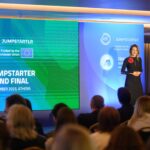A mountainous country with diverse topography, Tajikistan is especially vulnerable to climate change, prone to earthquakes, floods, drought, avalanches, landslides and mudslides.
The most vulnerable areas are the glacier-dependent river basins supplying hydropower and water resources for irrigation, fragile mountain ecosystems and isolated forest with mountainous and riverine terrain which makes it prone to landslides and land degradation.
This week at the COP29 climate conference in Baku, Azerbaijan, Daler Juma, Tajikistan’s energy and water resources minister, revealed just how much the country was being impacted by climate change.
“Over the past 30 years, out of 14,000 glaciers in Tajikistan, more than 1,000 glaciers of vital importance to the entire region have disappeared,” he said.
“The rapid melting of glaciers due to climate change is a serious threat in the global context of protecting water resources,” he added, speaking at an event organised by Kyrgyzstan, another Central Asian nation also facing the issue of melting glaciers due to rising temperatures.
According to the Korean-based Green Climate Fund, hydropower supplies around 98 per cent of Tajikistan’s electricity. The country’s hydropower plants depend on river basins fed by glacial melt water and snow melt.
If its glaciers disappear, the country’s electricity supply is at risk.
This makes climate action crucial to the country’s future, but also offers Tajikistan an opportunity to rejuvenate its economy and create jobs while protecting its people from the growing risks of extreme weather events, according to the World Bank Group’s Tajikistan Country Climate and Development Report (CCDR), published last week.
Economic reset
While the Tajik government has set out an agenda to transform the country’s economy through a green transition, the report finds that it can go further to ensure a resilient development path.
A complementary reform programme is needed to bring significant economic benefits for the country and the broader region, adaptation to climate change, and decarbonisation of the Central Asia electricity systems.
“Tajikistan is in urgent need of an economic reset that can help address its many development challenges as well as significant and increasing impacts of climate change that are threatening future progress,” says Ozan Sevimli, World Bank Group country manager for Tajikistan.
Mobilising private finance, to complement limited public resources, will be key to the success of the green transition to achieve water, food, and energy security; low-carbon development that could boost exports and create jobs; and protect the vulnerable through effective climate strategies.
“Although Tajikistan ranks 130th in global greenhouse gas emissions with a minimal contribution, it is recognised as one of the world’s most vulnerable countries to climate change,” notes Bahodur Sheralizoda, chair of the environmental protection committee under the government of Tajikistan.
The CCDR offers recommendations for the government of Tajikistan on enhancing production efficiency, promoting innovative technologies, and creating ‘green’ jobs, all while reducing the country’s vulnerability to climate change impacts.
The cost of inaction
The cost of inaction is high. Climate change-related damages to infrastructure, livestock productivity, and agriculture could reduce real GDP by five to six per cent by 2050. Climate-induced impacts in the strategic Vakhsh River Basin, where 90 per cent of the country’s electricity is generated, epitomise the climate and development challenges of Tajikistan.
The annual average costs of land degradation in Tajikistan are estimated at nearly 325 million US dollars, a cost that is only expected to rise. In addition, air pollution is rife, accounting for 84 deaths per 100,000, which is the second highest in Central Asia.
The pursuit of a green and resilient development hinges on implementing a broad spectrum of structural reforms to lay the foundation for general economic development.
In particular, Tajikistan the CCDR suggests that the country should focus on opening up its economy to better attract private investment and improve public service delivery, including through better governance in state-owned enterprises.
In addition, strengthening the education, health care, and social protection systems is vital for human capital development and equipping the workforce with the needed skills.
Time to open up the economy
There are considerable benefits to be reaped from a green transition. Reductions in health care costs from reduced air pollution, road accidents, and road damage are estimated to exceed 3.5 billion US dollars by 2050.
Investment in renewable energy and energy efficiency have the potential to generate new employment opportunities.
Nevertheless, significant investments will be needed for the climate mitigation and adaptation agenda.
It is estimated that Tajikistan would require around 17 billion US dollars on top of the investments for the ambitious reform agenda of the government with investment needs of 79 billion US dollars during 2025–2050.
A large share of investments could come from the private sector, particularly in the energy, industry and agriculture sectors, but improvements to the business regulatory environment, opening up the economy and levelling the playing field for better competition will be required to unlock private capital.







